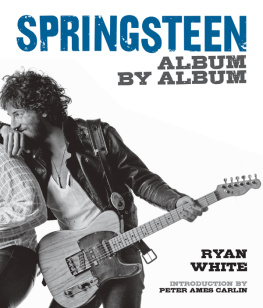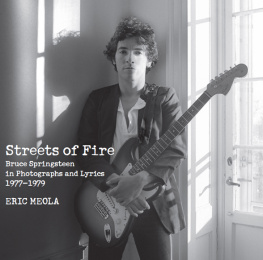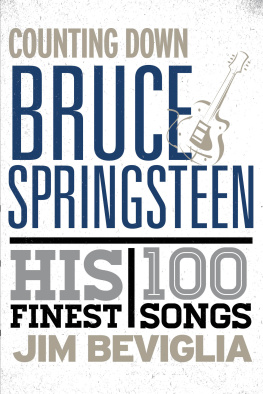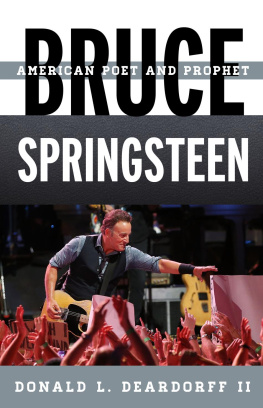BRUCE SPRINGSTEEN

THIS IS A CARLTON BOOK
Published by Carlton Books Ltd
20 Mortimer Street
London W1T 3JW
Text copyright 2019 Brian Hiatt
Design copyright 2019 Carlton Books Ltd
All rights reserved. No part of this publication may be reproduced, stored in a retrieval system, or transmitted in any form or by any means (including electronic, mechanical, photocopying, recording, or otherwise) without prior written permission from the publisher.
ISBN 978-1-78739-121-5
Editorial Director: Roland Hall
Editorial Assistant: Georgia Goodall
Design: Russell Knowles, James Pople
Production: Yael Steinitz
Picture Research: Steve Behan
A CIP catalogue for this book is available from the British Library
10 9 8 7 6 5 4 3 2 1


CONTENTS

CHAPTER 1 - 1973
GREETINGS FROM ASBURY PARK, N.J
CHAPTER 2 - 1973
THE WILD, THE INNOCENT & THE E STREET SHUFFLE
CHAPTER 3 - 1975
BORN TO RUN
CHAPTER 4 - 1978
DARKNESS ON THE EDGE OF TOWN
CHAPTER 5 - 1980
THE RIVER
CHAPTER 6 - 1982
NEBRASKA
CHAPTER 7 - 1984
BORN IN THE U.S.A.
CHAPTER 8 - 1987
TUNNEL OF LOVE
CHAPTER 9 - 1992
HUMAN TOUCH
CHAPTER 10 - 1992
LUCKY TOWN
CHAPTER 11 - 1995
GREATEST HITS SESSIONS
CHAPTER 12 - 1995
THE GHOST OF TOM JOAD
CHAPTER 13 - 2002
THE RISING
CHAPTER 14 - 2005
DEVILS &DUST
CHAPTER 15 - 2007
MAGIC
CHAPTER 16 - 2009
WORKING ON A DREAM
CHAPTER 17 - 2012
WRECKING BALL
CHAPTER 18 - 2014
HIGH HOPES


INTRODUCTION


Frank Stefanko portrait of Bruce Springsteen, 2017.
Y ou can try to explain it all. You can figure out the first two lines of Badlands probably came from the 1977 New York City blackout; you can prove there were no fireworks in Asbury Park the year 4th of July (Asbury Park) emerged; you can find the precise book and newspaper passages quoted on The Ghost of Tom Joad; you can trace songs from their earliest drafts; you can talk to people involved every step of the music-making and recording process. Nevertheless, the butterfly cant quite be pinned down. How did Bruce Springsteen write and record all those songs? Thankfully, that question cant be fully answered, even by Bruce Springsteen.
All that said, this book goes a long way towards unraveling the inspirations and creative process behind Springsteens songs and recordings, with entries on every officially released studio track between 1973s Greetings From Asbury Park, N.J. and 2014s High Hopes. Among many other sources, it draws from 55-plus hours of new interviews I conducted with Springsteens collaborators musicians (E Street Band members Roy Bittan, Max Weinberg, Nils Lofgren and Soozie Tyrell, plus Tom Morello and many more) producers (Mike Appel, Chuck Plotkin, Brendan OBrien and Ron Aniello) and engineers (Jimmy Iovine, Toby Scott and many others) from every phase of his career. Other key resources included my five interviews with Springsteen himself (all conducted between 2004 and 2016 for Rolling Stone) and raw transcripts of other Springsteen interviews, including many previously unpublished quotes, shared with me by incredibly generous colleagues. (All of my own fresh interview quotes are presented in present tense: Roy Bittan says...) For a full list of interviewees and sources, see .
The power of Springsteens live performances, with or without the E Street Band (but especially with them) is such that they tend to overshadow the studio recordingssometimes even in the mind of their creator. This book, however, is a chronicle of Bruce Springsteen as a recording artist, not just a songwriter, and digging in hard on the studio process provided some essential insights. (Springsteens rhythm guitar is more of a driving force behind his recordings than most listeners might realize, for instance: the brilliant mix engineer Bob Clearmountain tells me that Springsteen refers to his electric rhythm parts as the primal scrub.) The focus on Springsteens own compositions and official studio releases does mean there are a few omissions here: from great songs like Seeds and Light of Day that are as yet unheard in studio recordings, to the entire Seeger Sessions album, to the many bootlegged studio tracks that still havent been released.
At the beginning of the book, we find Springsteen unburdened by doubt, a twenty-two-year-old laying down his first album without hesitation. Soon, his process grows as tortured as it is productive: the number of classic or near-classic songs he wrote, recorded and tossed away between 1977 and 1984 is astounding. (Thanks to his boxed set Tracks, and subsequent expanded album reissues, many of those songs have seen belated official release, and are included in this book.) By the 21st century, Springsteen recovers his initial nonchalance, writing with purpose and certainty, and recording quickly.
Many of the anecdotes in this book capture a vanished pre-digital era, when the record industry could allow a young artist to record for months on end, live in the studio with his road-tested bandwhen, as on Something in the Night and Born in the U.S.A. a gesture from a frontman to his drummer could result in a spontaneous musical moment captured forever.
I was fortunate enough to spend many hours talking to Weinberg, the kind of drummer who remembers the exact details of those gesturesand just about everything elseforty years down the road. The importance of Springsteens musicians, the E Street Band chief among them, comes through over and over hereBittan, his keyboardist since 1974, had many revelations to offer on how he and the rest of the band helped the songs take shape.
Reevaluating Springsteens catalog, song by song, offers a reminder of the essential seriousness of his project (producer Chuck Plotkin tells me that Springsteen approached it all with the gravity of a brain surgeon), and of the near-constant internal battles waged along the way. The moments of joy and triumph in his music are hard-fought, and oftentimes not what they seem. White Americans seem to feel that happy songs are happy and sad songs are sad, James Baldwin once wrote, and that, God help us, is exactly the way most white Americans sing them. For Springsteen, that was never a problem.
Brian Hiatt, New York, 2019

Next page
















